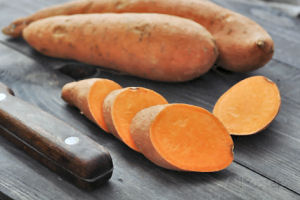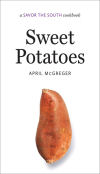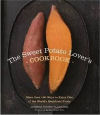
HOME
INTRO
SYMBOLS
ALMANAC
ECONOMY
GEOGRAPHY
STATE MAPS
PEOPLE
FORUM
NEWS
COOL SCHOOLS
STATE QUIZ
STATE LINKS
BOOK STORE
MARKETPLACE
GUESTBOOK
CONTACT US


You may double left-click on a word on this page to retrieve its definition. Tweet Follow
Louisiana State Vegetable

State Representative Nita Rusich Hutter
On March 21, 2003, State Representative Nita Rusich Hutter, representing District 104, St. Bernard Parrish, prefiled House Bill No. 633 in the Louisiana House of Representatives.
House Bill No. 633 proposed that the Creole tomato be designated the official "vegetable plant" of Louisiana.
On March 31, 2003 the bill was referred to the House Judiciary Committee where it received unanimous approval on May 22, 2003.
On May 27, 2003 House Bill No. 633 was passed by a vote of the full House of Representatives. It was ordered on to the Louisiana Senate for that chamber's consideration.

Louisiana State Vegetable: Sweet Potato
Orange flesh sweet potato photograph
Referred to the Senate & Governmental Affairs Committee on May 28, it was here that the sweet potato entered the discussion.
We are not yet certain of the circumstances that led to inclusion of the sweet potato in this piece of legislation but, as approved by the committee, House Bill No.633 had been amended to include the designation of the sweet potato as Louisiana's official state vegetable along with the Creole tomato as the official state vegetable plant. Please contact us if you have further information on this subject.
Put to a vote before the full Senate, House Bill NO.633, as amended by the Senate committee was approved overwhelmingly (28-2) on June 16, 2003.
The House of Representatives agreed (89-11) to the Senate amendment on June 18, 2003.
Signed by the President of the Senate and the Speaker of the House of Representatives the amended House Bill No. 633 was forwarded to the governor for her approval, three days later, on June 21st.
Governor Kathleen Babineaux Blanco signed House Bill No. 633, Act No. 857, on July 1, 2003 making the Creole tomato the official state vegetable plant and the sweet potato the official state vegetable.
The law went into effect on August 15, 2003.
ENROLLED
ACT NO. 857
Regular Session, 2003
HOUSE BILL NO. 633
BY REPRESENTATIVE HUTTERAN ACT
To enact R.S. 49:170.8, to designate the Creole Tomato as the state vegetable plant; to designate the sweet potato as the state vegetable; and to provide for related matters.
Be it enacted by the Legislature of Louisiana:
Section 1. R.S. 49:170.8 is hereby enacted to read as follows:
§170.8. State vegetable plant; state vegetable
A. There shall be an official state vegetable plant. The official state vegetable plant shall be the Creole Tomato. Its use on official documents of the state and with the insignia of the state is hereby authorized.
B. There shall be an official state vegetable. The official state vegetable shall be the sweet potato. Its use on official documents of the state and with the insignia of the state is hereby authorized.
SPEAKER OF THE HOUSE OF REPRESENTATIVES
PRESIDENT OF THE SENATE
GOVERNOR OF THE STATE OF LOUISIANA
APPROVED:
Page 1 of 1
CODING: Words in struck through type are deletions from existing law; words underscored are additions.
What's the difference between a sweet potato and a yam?
We think it's important to offer a brief discussion here to differentiate sweet potatoes from yams because, as a marketing endeavor, sweet potatoes have been described as and are often called yams in Louisiana.
When the orange-fleshed, Puerto Rican variety of sweet potatoes was adopted by Louisiana producers and shippers, they were called "yams" to distinguish them from the white-fleshed sweet potatoes grown in other parts of the country. The yam reference became the trademark for Louisiana-grown sweet potatoes.
(Ehler, "Sweet Potato Trivia & Facts")
In fact, sweet potatoes are not related to yams. Sweet potatoes and yams are classified in two different botanical families; Convolvulaceae and Dioscoreaceae respectively. Yams are related to grasses and lilies while sweet potatoes are related to morning glories.
Yams are native to Asia and Africa. Sweet potatoes are native to tropical locations in the Americas.
The skin of a yam, which varies in color from dark brown to light pink, is rough and difficult to cut. The meat, or flesh, ranges in color from white or yellow to purple or pink in more mature yams.
The skin of sweet potato is smooth and can be colored yellow, orange, red, brown, purple, or beige. The meat, or flesh, of sweet potatoes is also variable ranging in color from beige through white, red, pink, violet, yellow, orange, and purple.
North Carolina has also selected the sweet potato as its official state vegetable.
Louisiana Law
The following information was excerpted from the Louisiana Revised Statutes, Title 49, Section 49:170.11.
TITLE 49.STATE ADMINISTRATION
RS 49:170.11vState vegetable plant; state vegetable
RS 49:170.11
§170.11. State vegetable plant; state vegetable
A. There shall be an official state vegetable plant. The official state vegetable plant shall be the Creole Tomato. Its use on official documents of the state and with the insignia of the state is hereby authorized.
B. There shall be an official state vegetable. The official state vegetable shall be the sweet potato. Its use on official documents of the state and with the insignia of the state is hereby authorized.
Acts 2003, No. 857, §1.
Sources...
Ehler, James T. "Sweet Potato Trivia & Facts." Food Reference.com. Chef James T. Ehler, n.d. Web. 21 Oct. 2016.
Reynolds, Gene. "HCR88 by Representative Gene Reynolds." Louisiana State Legislature. State of Louisiana, 7 May 2015. Web. 14 Oct. 2016.
"RS 49:170.11." Louisiana State Legislature. State of Louisiana, 14 Oct. 2016. Web. 15 Oct. 2016.
Additional Information
Sweet Potato: Sweet potato description from the Food Network's Food Encyclopedia.
What is the difference between sweet potatoes and yams?: Everyday Mysteries: Fun Science Facts from the Library of Congress.
Sweet Potato Trivia & Facts: Chef James T. Ehler's Food Reference.com.
Sweet Potatoes: Website of Louisiana State University's (LSU) AgCenter.
Sweet Potato Growing Guide: From the Southern Exposure Seed Exchange.
32 Delicious New Ways to Prepare Sweet Potatoes: From Country Living magazine.
Sweet Potato Recipes: From AllRecipes.com.
Sweet Potato Recipes: from the Food Network.

The Louisiana Yambilee Festival
The Louisiana Yambilee Festival: Website of The Louisiana Yambilee Festival, held in Opelousas, and running from the Wednesday of the last full weekend of October and continuing throughout the weekend.
State vegetables: Complete list of official state vegetables from NETSTATE.COM.
More symbols & emblems: Complete list of official Louisiana state symbols from NETSTATE.COM.

Sweet Potatoes
April McGreger
Sweet Potatoes, by April McGreger. 152 pages. Publisher: The University of North Carolina Press; 1st Edition (September 15, 2014)
In this paean to the brightly colored root, April McGreger tells the multifaceted history of a fundamental southern food, praising its rich and diverse savory-to-sweet flavor profile, botanical varieties, and shockingly high nutritional value. Along with instructions for selection and storage, McGreger shares the fifty best sweet potato recipes in the world. Embracing but going well beyond the classics--from Sweet Potato Pone and Candied Sweet Potatoes to Sweet Potato Chiles Rellenos and Sweet Potato-Ginger Crèmes Caramels--McGreger's creations will delight and satisfy with their deliciousness and versatility.
McGreger relates a tale from a traveler in 1940s Mississippi who said he ate "sweet potatoes with wild turkeys and various other meats, had a potato pie for dessert and roasted potatoes offered to him as a side dish, drank sweet potato coffee and sweet potato home brew, had his horse fed on sweet potatoes and sweet potato vines, and when he retired he slept on a mattress stuffed with sweet potato vines and dreamed he was a sweet potato someone was digging up." The sweet potato is no less important to McGreger, the daughter and sister of Mississippi sweet potato farmers.

The Sweet Potato
Lover's Cookbook
Lyniece North Talmadge
The Sweet Potato Lover's Cookbook: More than 100 ways to enjoy one of the world's healthiest foods, by Lyniece North Talmadge. 240 pages. Publisher: Cumberland House; 2nd Edition (November 1, 2010)
Enjoy sweet potatoes year-round with recipes for appetizers, soups, main courses, side dishes, and even breakfasts and desserts!
As every sweet potato lover knows, it's more than just a holiday side dish-it's one of the world's healthiest and most flavorful foods! In this unique collection bursting with over one hundred recipes, you'll find easy-to-make dishes that highlight the natural and delicious flavors of this versatile vegetable.
- Orange Butter Sweet Potato Waffles
- Andouille Sausage and Sweet Potato Soup
- Sweet Potato Dumplings
- Spiced Sweet Potato Chips
- Candied Sweet Potatoes
- Easy Caramel Sweet Potato Pie
- And more!
The Omnivore's Dilemma: A Natural History of Four Meals, by Michael Pollan. 464 pages. Penguin Press HC, The (April 11, 2006) The bestselling author of The Botany of Desire explores the ecology of eating to unveil why we consume what we consume in the twenty-first century
In Defense of Food: An Eater's Manifesto, by Michael Pollan. 256 pages. Penguin Press HC, The (2008) In looking toward traditional diets the world over, as well as the foods our families-and regions-historically enjoyed, we can recover a more balanced, reasonable, and pleasurable approach to food. Michael Pollan's bracing and eloquent manifesto shows us how we might start making thoughtful food choices that will enrich our lives and enlarge our sense of what it means to be healthy.

